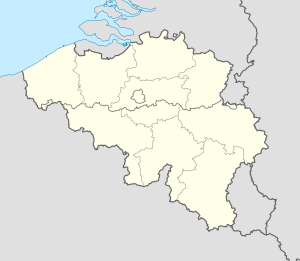Fort de Fléron
| Fort de Fléron | |
|---|---|
| Part of Fortifications of Liège | |
| Fléron, Belgium | |

Memorial and wall at Fléron
|
|
| Coordinates | 50°37′03″N 5°41′32″E / 50.61763°N 5.6922°E |
| Type | Fort |
| Site information | |
| Controlled by | Belgium |
| Condition | Buried |
| Site history | |
| Built | 1881 |
| Materials | Unreinforced concrete |
| Battles/wars | Battle of Liège, Battle of Belgium |
Coordinates: 50°37′04.1″N 5°41′32.1″E / 50.617806°N 5.692250°E
The Fort de Fléron is one of twelve forts built as part of the Fortifications of Liège in the late 19th century in Belgium. It was built between 1881 and 1891 according to the plans of General Henri Alexis Brialmont. Contrasting with the French forts built in the same era by Raymond Adolphe Séré de Rivières, the fort was built exclusively of unreinforced concrete, a new material, rather than masonry. The fort was heavily bombarded by German artillery in the Battle of Liège. Fléron was upgraded in the 1930s to become part of the fortified position of Liège in an attempt to forestall or slow an attack from Germany. Located in the center of Fléron, the fort has been buried and is surrounded by apartments.
The Fort de Fléron is located about 7 kilometres (4.3 mi) southeast of the center of Liège, in the center of Fléron. The fort formed an isosceles triangle whose base is 300 metres (980 ft) long and whose sides measured 235 metres (771 ft). A 6-metre (20 ft) deep by 8-metre (26 ft) ditch encircled the fort. The principal armament was concentrated in the central massif. The ditches were defended in enfilade by 57mm guns in casemates resembling counterscarp batteries, firing at shot traps at the other end of the ditch. One of the larger forts of Liège, it was armed with heavy artillery in rotating turrets, concentrated in a central massif. The compact center was surrounded by four turrets with lighter guns for close defense.
...
Wikipedia

